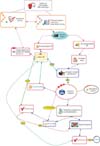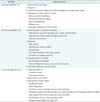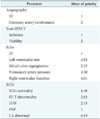This article has been
cited by other articles in ScienceCentral.
Abstract
Objectives
Monitoring heart failure patients through continues assessment of sign and symptoms by information technology tools lead to large reduction in re-hospitalization. Agent technology is one of the strongest artificial intelligence areas; therefore, it can be expected to facilitate, accelerate, and improve health services especially in home care and telemedicine. The aim of this article is to provide an agent-based model for chronic heart failure (CHF) follow-up management.
Methods
This research was performed in 2013-2014 to determine appropriate scenarios and the data required to monitor and follow-up CHF patients, and then an agent-based model was designed.
Results
Agents in the proposed model perform the following tasks: medical data access, communication with other agents of the framework and intelligent data analysis, including medical data processing, reasoning, negotiation for decision-making, and learning capabilities.
Conclusions
The proposed multi-agent system has ability to learn and thus improve itself. Implementation of this model with more and various interval times at a broader level could achieve better results. The proposed multi-agent system is no substitute for cardiologists, but it could assist them in decision-making.
Keywords: Health Information Systems, Heart Failure, Artificial Intelligence, Multi-agent Systems
I. Introduction
Chronic heart failure (CHF) is an increasingly common and complex health problem that accounts for at least 290,000 deaths in the United States alone each year. Based on the severity and deterioration of their status, CHF patients receive different types of health services from easy to advanced therapy [
1]. CHF is a costly disease in most countries. For example, in the United States, the total cost of this disease was estimated to be $39.2 billion in 2010. A large portion of the costs are allocated to hospitalization and re-admission. CHF has high morbidity and mortality rates due to exacerba tions of patient status [
2].
Heart failure impairs the quality of life, and it imposes a considerable economic cost and social burden on society; therefore, the prevention of this chronic disease and appropriate health activity management are very important [
3]. A follow-up plan and disease management for CHF patients have a significant role in reducing health care utilization, decreasing rates of re-hospitalization, and improving outcomes. Due to advances in medical sciences and technology, the use of modern technology to improve follow-up management programs is inevitable [
4].
Monitoring heart failure patients through continuous assessment of sign and symptoms, checking compliance with self-management programs by information technology tools and intelligent systems lead to large reductions in hospitaliza tion rates [
5]. Application agent technology is one of the strongest artificial intelligence areas, and it can facilitate, accelerate and improve health services for CHF patients, especially in home care and telemedicine settings. An agent is a computer system, situated in a dynamic and unpredictable environment. It is capable of flexible autonomous action to meet its design objectives [
6].
Mobility is one of the characteristics of agents. This specification is suitable for telemedicine and e-Health systems [
7]. Agents have social ability. This means they can be coordinated to be interoperable with each other and other systems in distributed and dynamic environments to achieve their goals. Health systems based on this technology are able to interact with a continually changing world and make autonomous and flexible decisions [
8]. This capability is very important, especially in the remote monitoring of CHF patient and self-management programs. Agent can operate through various types of tools, such as mobile devices [
9], so they can be used easily in telemedicine. Autonomy, reactivity, goal directed behavior, coordination with other agents, flexibility, communication and cooperation between independent elements, learning, reusability, intelligence, prediction ability, rationality, transparency, and accountability are some of the properties of agents [
10]. Because of these abilities, agents can provide a suitable infrastructure for CHF follow-up management. The aim of this article is to provide a model for CHF follow-up management based on a multi-agent system.
II. Methods
This research was performed in 2013-2014 to determine an appropriate scenario for follow-up of patients with CHF. An appropriate scenario was determined by studying American, European, and Australian heart failure guidelines; the results were obtained using the Delphi method by surveying 20 experts, including cardiologists (16 people), health information managers, and medical informatics experts (4 people). The final scenario was plotted with Mindjet MindManager 8 software (Mindjet, San Francisco, CA, USA). As discussed in next section, the data required for the monitoring and follow-up of CHF patients was identified by studying the American, European, and Australian heart failure guidelines and consultation with cardiologists. The minimum dataset (MDS) requirements for monitoring CHF were formulated as a checklist with six main parts, including demographic, clinical, examination, exercise test, drug, procedure, and imaging. This MDS was distributed to 16 cardiologists, and their comments and their ranking of each item was collected after discussion. Then, the identified priorities were imported into Microsoft Excel, and the mean for each item was considered as its priority. After that, the agent-based follow-up model was designed according to the previous mentioned results and agent-oriented analysis (AOA) methods. AOA is the process that deals with the discovery, documentation, and preservation of an actor's defined roles, responsibilities, and interactions in to design an agent-based system [
11]. Through this method, general tasks and processes in the designed scenario were defined, and necessary agents were determined. The performance of one of the agents in this model was assessed according to real data of CHF patients who were discharged in 2013 from a heart center. MDS for monitoring CHF were collected during 5 months in three different sections of follow-up. The gathered data was imported using RapidMiner 5 software (RapidMiner Inc., Cambridge, MA, USA) and R programming language for intelligent data analysis. Due to various aspects of data use, various types of decision trees, such as ID3, CHAID, and C4.5, were considered for data modeling. Supervised methods such as decision tree are more appropriate for data analysis because it uses data labels, so it is more suitable for the implementation of agents. The status of a patient defined in as either follow-up or non-follow-up (death and hospitalization). A coefficient was assigned to each variable in the data analysis based on the average priority that cardiologists assigned to each variable, accessibility, and the importance of each variable from the viewpoint of a cardiologist and the cost of health services. Also, K-nearest neighbors (K-NN), an unsupervised method based on the same decision tree structure, was used in three follow-up steps. Evaluation was performed based on cross-validation, and voting was used for final data analysis. In the voting method, it is possible to apply and combine different algorithms from various models to obtain a suitable outcome.
III. Results
In the first phase of designing and implementing a multiagent system for the follow-up of CHF, it was necessary to define an appropriate scenario. To do this, three heart failure guidelines of Europe, America, and Australia were studied. These guidelines are generally very similar, and their differences were mostly limited to the form of their expressions. The important factors in the process of diagnosing and treating heart failure in these guidelines are listed in
Table 1.
Proposed scenario for follow-up of CHF according to cardiologist's viewpoint described in
Figure 1.
In the proposed scenario, assessment of the patient's clinical status after discharge is very important; therefore, determining the minimum data set for follow up monitoring of patients was necessary. In the second phase of this research, the minimum data categories for the follow-up of CHF patients was extracted from the comments of cardiologists and the studied guidelines. These six main categories of data are demographic, clinical, examination, drug, exercise test, and imaging/procedure, which includes angiography, echo, scan SPECT, and ECG. For each data category, the mean priority based on the comments of cardiologist was calculated in Microsoft Excel. The results were then used for weighting data in data analysis. The mean of priority for each item is listed in
Tables 2 and
3.
Designing agents as the third part of this research was possible after a suitable scenario was defined and the categories of data that should be considered in the follow-up plan were identified. It is certain that the application of information technology tools, such as multi-agent systems, in the field of chronic disease management has significant benefits for communities. The selection of any one of these technologies at the national level should be based on greater understanding of these tools and health care organization goals. Our multi-agent architecture model is proposed in accordance with the CHF follow-up scenario described in
Figure 1 to implement efficient mechanisms to support CHF follow-up management. This model could have important benefits, such as a reduction in the number of admissions, decreased mortality and morbidity rates because it can promptly notify patients and cardiologists when abnormal patient conditions occur.
The proposed model comprises various agents. The basic tasks applied by agents are the following:
Medical data access for monitoring patient status in a realtime
Intelligent data analysis including the following:
- Medical data processing for patient data interpretation
- Reasoning to evaluate the outcome of the processing procedure
- Negotiation for decision making to assess the individual outcome of each specific agent and generate an overall characterization of a patient's status
- Learning capabilities to improve the reasoning capabilities of agents and system performance
Communication with other agents of the framework for collaboration and knowledge sharing
Based on the parameters that have to be monitored during CHF follow-up, the following agent types may be distinguished: user agent, Web-based user interface agent, intelligent data analysis agent, electronic patient record agent, ontology agent, broker agent, administration and visit schedule agent, education agent, and hospital agent.
The proposed multi-agent model architecture is depicted in
Figure 2 with emphasis on the system functionality.
The proposed system is a user center. Two user agent levels are defined, namely, patient and physician. The behavior of the system is quite flexible and allows customization of the system according to user's preference. The platform is Web-based so users can access data through computers, mobile devices, PDAs, and through the Internet, Wi-Fi, and SMS at all times. Easy, rapid, and continuous user access to the system can facilitate the monitoring and follow-up of CHF patients.
As shown in
Figure 2, a user agent logs into the system through the Web-based user interface to find the needed information. The user interface agent is Web-based and is implemented through a Web service and a Web browser. Through the Web browser, the user is connected to the system. Information exchange is performed between agents and user with the connecting server and Web browser. This agent manages all user queries and requests.
The intelligent data analysis agent is used for problem detection, data analysis, general evaluation, prediction of patient status, and to make correct judgments about patients' condition. If a patient needs to visit the doctor, this agent connects to the administration and visit scheduling agent for access to the clinic schedule, and it schedules an appointment with a doctor. Also, if a patient needs education, this agent communicates with the education agent and provides es sential education to the patient about diet, drugs, and self-management.
After intelligent data analysis, if a patient needs to be hospitalized, relevant information regarding hospitals, departments, and bed status are provided to the patient through the hospital agent.
If more health information is needed, intelligent data analysis is connected to the electronic patient record agent to acquire the appropriate information. The availability of patient history and other related information for data analysis is necessary for follow-up. This is possible through the electronic patient record. Information mapping between the electronic patient record agent and intelligent data analysis is possible through the ontology agent.
After intelligent analysis, if the user needs education, an outpatient visit, or hospitalization, the broker agent communicates and connects with the relevant agent and provides the required information to the user. This system can handle a heavy workload and requires a significant amount of time and effort to accomplish all tasks. Accuracy of model based on different algorithms is shown in
Table 4.
IV. Discussion
CHF imposes heavy costs on the health systems of many countries. Despite advances in treatment methods, this disease is highly prevalent. Obviously, to the follow-up of CHF patients is necessary to decrease the common causes of readmission and to prevent the deterioration of patients' status. Nowadays, health data analysis without intelligent analysis tools is very difficult and sometimes impossible because of advances in the field of health and the increasing complexity of health data.
Data analysis using artificial intelligence techniques is an important tool that can provide access to the knowledge hidden in the huge clinical and administration databases of hospitals. Also, providing useful knowledge to healthcare personnel can support decision making and increase the quality of prevention, treatment, and diagnosis plans. Agent technology is one of the strongest tools in the artificial intelligence field, and it can help to implement appropriate infrastructure for improved data analysis and CHF follow-up management.
The proposed agent-based model for intelligent data analysis of CHF follow-up can be implemented on two user levels (patient and physician). Cardiologists can be directly involved in intelligent data analysis and use his/her priorities for data analysis or consult the opinions of other cardiologists and use the priorities of others that exist in the system. This system, like other multi-agent systems in the health domain, uses Web services for interoperability with other information systems. It is easy, and fast and can be accessed online 24 hours a day. Information exchange between agents and among users with a system must be done securely. Important factors in the implementation of the proposed system should be considered: definition of security requirements, determination of access levels, and user authentication, especially in application profiles, electronic patient record management, access control, and encryption of transferred data. Also, it should be noted that a security layer in data, tools, network and user levels, compliance with the principles of confidentiality, and disclosure of information are very critical.
The proposed intelligent system has the ability to learn and improve itself. Implementation of the model with more data and various interval times at a broader level may achieved better results.
Physicians rely on evidence-based medicine more than facts resulting from software. However, intelligent data analysis is facing enormous challenges due to the diversity of the data and specific conditions of health domains. The limited amount of disease-related data, uneven distribution of classes due to limited numbers of samples (for example the number of people with a particular disease less than those without the disease), lack of electronic medical guidelines and decision support systems that can help physicians in decision-making are the main obstacles in the medical knowledge domain, and this research has been faced with them. In this study, despite the importance of the minimum data set of CHF, some of these categories of data were left out of the intelligent analysis because they were not recorded in the hospital information system (HIS) of heart center considered here. Therefore, it is recommended that, in the design and use of HISs, the registration and collection of data needed to track the status of patients with CHF should be implemented.
The proposed multi-agent system is no substitute for cardiologists, but it could be a useful tool for decision-making. Lack of physician trust in intelligent analysis is the greatest obstacle to the implementation of intelligent system in all countries. In this study, to eliminate this obstacle, we tried to benefit from consultation with cardiologists in addition to software specialist and health information management experts. By applying what we have learned from cardiologists' comments, report results, and feedback to the proposed system, design, we hope it will have a significant effect on physician trust and acceptance.
Figures and Tables
Figure 1
Proposed scenario for follow-up chronic heart failure (CHF) plotted with Mindjet MindManager 8.

Figure 2
Proposed architecture for chronic heart failure follow-up management based on agent.

Table 1
Important factors in the diagnosis and treatment of heart failure in the studied guidelines as identified by the research team

Table 2
Minimum data set for follow-up monitoring of chronic heart failure patients

Table 3
Minimum data set for monitoring follow-up chronic heart failure patients in imaging/procedure section

Table 4
Accuracy of model based on different algorithms

Acknowledgments
This research was performed as a part of a PhD thesis in health information management by Niloofar Mohammadzadeh in the School of Allied Medical Sciences of Tehran University of Medical Sciences. Our gratitude for unwavering support of this research goes to the Tehran Heart Center, Dr. Ali Bozorgi, cardiologist and assistant professor of Tehran University of Medical Sciences, and Dr. Hamid Beigi associate professor of the computer engineering department of Sharif University of Technology.
References
1. Ky B, French B, Levy WC, Sweitzer NK, Fang JC, Wu AH, et al. Multiple biomarkers for risk prediction in chronic heart failure. Circ Heart Fail. 2012; 5(2):183–190.

2. Heidenreich PA, Sahay A, Kapoor JR, Pham MX, Massie B. Divergent trends in survival and readmission following a hospitalization for heart failure in the Veterans Affairs health care system 2002 to 2006. J Am Coll Cardiol. 2010; 56(5):362–368.

3. Koehler F, Winkler S, Schieber M, Sechtem U, Stangl K, Bohm M, et al. Impact of remote telemedical management on mortality and hospitalizations in ambulatory patients with chronic heart failure: the telemedical interventional monitoring in heart failure study. Circulation. 2011; 123(17):1873–1880.

4. Mohammadzadeh N, Safdari R, Rahimi A. Multi-agent system as a new approach to effective chronic heart failure management: key considerations. Healthc Inform Res. 2013; 19(3):162–166.

5. Abraham WT, Adamson PB, Bourge RC, Aaron MF, Costanzo MR, Stevenson LW, et al. Wireless pulmonary artery haemodynamic monitoring in chronic heart failure: a randomised controlled trial. Lancet. 2011; 377(9766):658–666.

6. Dunin-Keplicz B, Verbrugge R. Teamwork in multiagent systems: a formal approach. Hoboken (NJ): John Wiley & Sons;2011.
7. Villar A, Federici A, Annicchiarico R. Agents and healthcare: a glance to the future. In : Annicchiarico R, Cortes U, Urdiales C, editors. Agent technology and e-health. Basel, Switzerland: Birkhauser;2008. p. 141–148.
8. Mala M. A multi-agent system based approach to emergency management. In : Proceedings of 2012 6th IEEE International Conference on Intelligent Systems; 2012 Sep 6-8; Sofia, Bulgaria. p. 95–101.
9. Rodriguez S, Corchado JM, Fernandez A, Ossowski S, Julian V, Botti V. A THOMAS based multi-agent system for recommendations and guidance in malls. J Phys Agent. 2009; 3(2):21–26.

10. Protogeros N. Agent and web service technologies in virtual enterprises. Hershey (PA): Information Science Reference;2008.
11. Lin H. Architectural design of multi-agent systems: technologies and techniques: technologies and techniques. Hershey (PA): Information Science Reference;2007.
12. McMurray JJ, Adamopoulos S, Anker SD, Auricchio A, Bohm M, Dickstein K, et al. ESC Guidelines for the diagnosis and treatment of acute and chronic heart failure 2012: The Task Force for the Diagnosis and Treatment of Acute and Chronic Heart Failure 2012 of the European Society of Cardiology. Developed in collaboration with the Heart Failure Association (HFA) of the ESC. Eur Heart J. 2012; 33(14):1787–1847.
13. Jessup M, Abraham WT, Casey DE, Feldman AM, Francis GS, Ganiats TG, et al. 2009 focused update: ACCF/AHA Guidelines for the diagnosis and management of heart failure in adults: a report of the American College of Cardiology Foundation/American Heart Association Task Force on Practice Guidelines: developed in collaboration with the International Society for Heart and Lung Transplantation. Circulation. 2009; 119(14):1977–2016.





 PDF
PDF ePub
ePub Citation
Citation Print
Print








 XML Download
XML Download